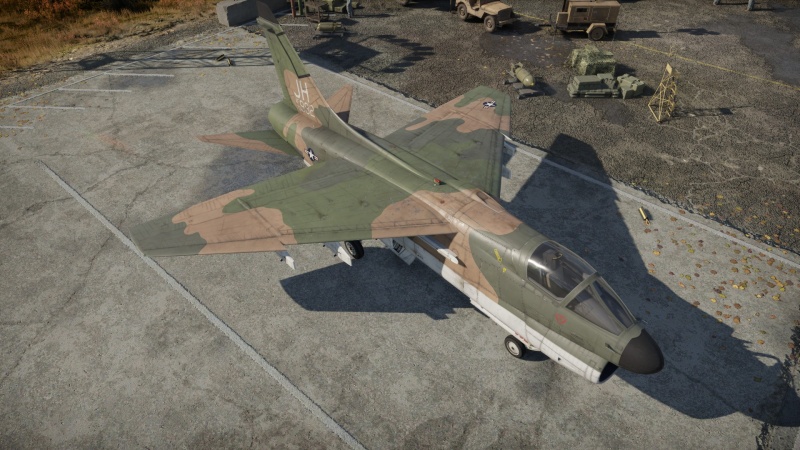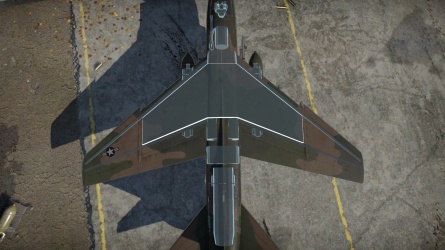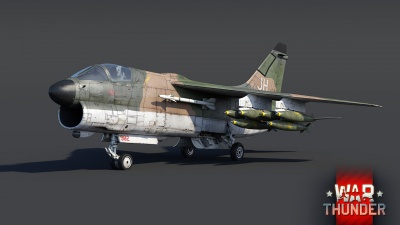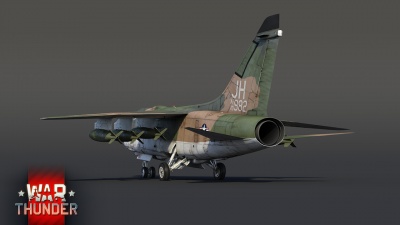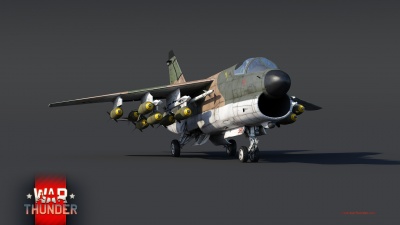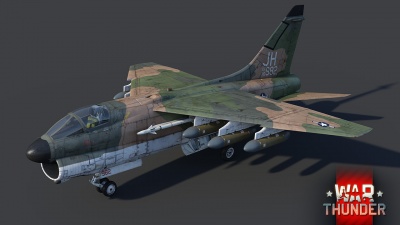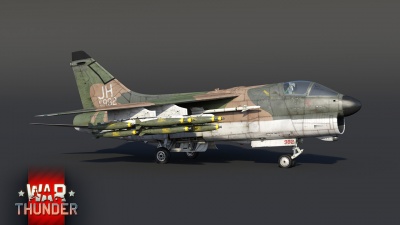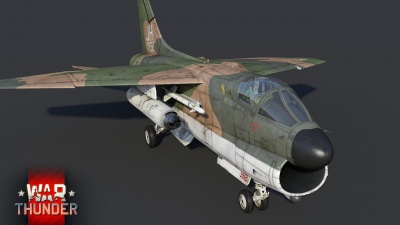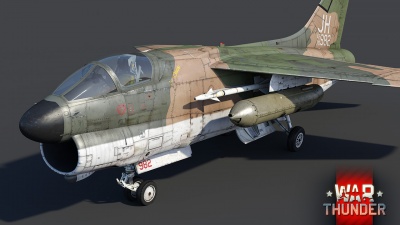A-7D
Contents
Description
The A-7D Corsair II is a rank American strike aircraft with a battle rating of (AB), (RB), and (SB). It was introduced in Update "Hot Tracks".
General info
Flight performance
| Characteristics | Max Speed (km/h at 0 m - sea level) |
Max altitude (metres) |
Turn time (seconds) |
Rate of climb (metres/second) |
Take-off run (metres) | |||
|---|---|---|---|---|---|---|---|---|
| AB | RB | AB | RB | AB | RB | |||
| Stock | 1,115 | 1,110 | 35.4 | 37.1 | 42.6 | 42.3 | 1,000 | |
| Upgraded | 1,132 | 1,123 | 34.6 | 35.0 | 68.4 | 55.0 | ||
Details
| Features | |||||
|---|---|---|---|---|---|
| Combat flaps | Take-off flaps | Landing flaps | Air brakes | Arrestor gear | Drogue chute |
| ✓ | ✓ | ✓ | ✓ | ✓ | X |
| Limits | ||||||
|---|---|---|---|---|---|---|
| Wings (km/h) | Gear (km/h) | Flaps (km/h) | Max Static G | |||
| Combat | Take-off | Landing | + | - | ||
| 484 | 457 | 406 | ~10 | ~4 | ||
| Optimal velocities (km/h) | |||
|---|---|---|---|
| Ailerons | Rudder | Elevators | Radiator |
| < 700 | < 690 | < 500 | N/A |
Engine performance
| Engine | Aircraft mass | |||||||
|---|---|---|---|---|---|---|---|---|
| Engine name | Number | Basic Mass | Wing loading (full fuel) | |||||
| Allison TF-41-A-1 | 1 | 9,101 kg | 382 kg/m2 | |||||
| Engine characteristics | Mass with fuel (no weapons load) | Max Takeoff Weight | ||||||
| Weight (each) | Type | 15m fuel | 20m fuel | 30m fuel | 45m fuel | 50m fuel | ||
| 1,592 kg | Low-bypass turbofan | 10,361 kg | 10,781 kg | 11,902 kg | 12,882 kg | 13,302 kg | 19,051 kg | |
| Maximum engine thrust @ 0 m (RB / SB) | Thrust to weight ratio @ 0 m (102%) | |||||||
| Condition | 100% | WEP | 15m fuel | 20m fuel | 30m fuel | 45m fuel | 50m fuel | MTOW |
| Stationary | 6,073 kgf | N/A | 0.59 | 0.56 | 0.51 | 0.47 | 0.46 | 0.32 |
| Optimal | 6,134 kgf (200 km/h) |
N/A | 0.59 | 0.57 | 0.52 | 0.48 | 0.46 | 0.32 |
Survivability and armour
Design characteristics of the A-7D put its survivability in a mixed bag. While it has all the necessary traits to survive in a missile-frequent battle-rating, the plane design leaves survival beyond a hit minimal.
The radar warning receiver comes default with the plane, meaning it will be able to sense when an enemy plane has pinged it during its radar search, or is locking on for a SARH missile. This can give enough heads-up to an A-7D pilot to react appropriately to the situation.
Once upgrading the A-7D through Tier I modifications, the A-7D can acquire flares to use in the event when an aircraft gets on the A-7D tail (which will be frequent given the A-7D's poor turn rate) and fires an infrared missile. This can be really useful to thwart off a missile-run by an enemy diving onto the A-7D. The A-7D receives a large amount of flares too, with 120 units able to be expended, meaning that the A-7D can keep infrared missiles off for quite some time.
These flares can help out when using the A-7D to penetrate enemy lines and to reach distant ground target such as bases or the such. Such an attack will inevitably be discovered by the enemy high-performance jets at this battle-rating. One way to use the flares in this situation is to activate "Periodic Flares Release" control so that the flare automatically come out of the aircraft when the enemy begins closing in. While it may illuminate the A-7D to other enemy's visuals, it will deter easy infrared missile shots so that an enemy 3-5 kilometers behind the A-7D can't just carelessly pop off a missile and know it is a certain hit. This should allow enough time for the A-7D to successfully drop its payload onto its target and fly off hoping to either make it back to the airfield safety or make it into a friendly airspace envelope safely. However, without much external aid, it will be hard to shake off tailing enemy that follows through from the beginning of the attack run to its aftermath.
However, the overall A-7D design leaves no space for error when it comes to getting hit. There are no empty spaces in the aircraft that can be hit and the plane is left out without too much trouble. Firstly, all but one of the four fuel tanks on the A-7D is not self-sealing, which is bad for the fuel storage on the plane. Secondly, one of the fuel tanks is huge and makes up a good portion of the wingspan (and it's a not self-sealing one at that). If this tank is hit, it will leak a good portion of the plane fuel. That is, if the tank does not catch fire from the hit, and it will burn continuously as it is representing a large fuel reserve and is not self-sealing. Having this or other fuel tanks get hit is a crippling blow to the A-7D.
These traits mean the A-7D deals with the aftermath of a hit terribly, but it does have enough design feature so that missiles are not an instant doom for the A-7D.
Modifications and economy
Armaments
| Ballistic Computer | |||
|---|---|---|---|
| CCIP (Guns) | CCIP (Rockets) | CCIP (Bombs) | CCRP (Bombs) |
| |
|
|
|
Offensive armament
The A-7D is armed with:
- 1 x 20 mm M61 cannon, chin-mounted (1,000 rpg)
Suspended armament
The A-7D can be outfitted with the following ordnance:
- Without load
- 2 x 20 mm M61 cannons (1,200 rpg = 2,400 total)
- 2 x 20 mm M61 cannons + 2 x AIM-9E Sidewinder missiles
- 2 x 20 mm M61 cannons + 2 x AIM-9J Sidewinder missiles
- 2 x 30 mm GAU-13/A cannons (353 rpg = 706 total)
- 2 x 30 mm GAU-13/A cannons + 2 x AIM-9E Sidewinder missiles
- 2 x 30 mm GAU-13/A cannons + 2 x AIM-9J Sidewinder missiles
- 24 x 250 lb LDGP Mk 81 bombs (6,000 lb total)
- 24 x 250 lb LDGP Mk 81 bombs + 2 x AIM-9E Sidewinder missiles (6,000 lb total)
- 24 x 250 lb LDGP Mk 81 bombs + 2 x AIM-9J Sidewinder missiles (6,000 lb total)
- 24 x 500 lb LDGP Mk 82 bombs (12,000 lb total)
- 24 x 500 lb LDGP Mk 82 bombs + 2 x AIM-9E Sidewinder missiles (12,000 lb total)
- 24 x 500 lb LDGP Mk 82 bombs + 2 x AIM-9J Sidewinder missiles (12,000 lb total)
- 14 x 750 lb M117 cone 45 bombs (10,500 lb total)
- 14 x 750 lb M117 cone 45 bombs + 2 x AIM-9E Sidewinder missiles (10,500 lb total)
- 14 x 750 lb M117 cone 45 bombs + 2 x AIM-9J Sidewinder missiles (10,500 lb total)
- 12 x 1,000 lb LDGP Mk 83 bombs (12,000 lb total)
- 12 x 1,000 lb LDGP Mk 83 bombs + 2 x AIM-9E Sidewinder missiles (12,000 lb total)
- 12 x 1,000 lb LDGP Mk 83 bombs + 2 x AIM-9J Sidewinder missiles (12,000 lb total)
- 6 x 2,000 lb LDGP Mk 84 bombs (12,000 lb total)
- 6 x 2,000 lb LDGP Mk 84 bombs + 2 x AIM-9E Sidewinder missiles (12,000 lb total)
- 6 x 2,000 lb LDGP Mk 84 bombs + 2 x AIM-9J Sidewinder missiles (12,000 lb total)
- 114 x FFAR Mighty Mouse rockets
- 114 x FFAR Mighty Mouse rockets + 2 x AIM-9E Sidewinder missiles
- 114 x FFAR Mighty Mouse rockets + 2 x AIM-9J Sidewinder missiles
- 2 x AIM-9E Sidewinder missiles
- 2 x AIM-9J Sidewinder missiles
- 4 x AGM-65A missiles
- 4 x AGM-65A missiles + 2 x AIM-9E Sidewinder missiles
- 4 x AGM-65A missiles + 2 x AIM-9J Sidewinder missiles
- 4 x AGM-65A missiles + 2 x 2,000 lb LDGP Mk 84 bombs + 2 x AIM-9E Sidewinder missiles (4,000 lb total)
- 4 x AGM-65A missiles + 2 x 2,000 lb LDGP Mk 84 bombs + 2 x AIM-9J Sidewinder missiles (4,000 lb total)
- 4 x AGM-65A missiles + 2 x 750 lb M117 cone 45 bombs + 2 x AIM-9E Sidewinder missiles (1,500 lb total)
- 4 x AGM-65A missiles + 2 x 750 lb M117 cone 45 bombs + 2 x AIM-9J Sidewinder missiles (1,500 lb total)
The A-7D can carry an assortment of bombs and unguided/guided rockets that are familiar to players of the American attacker line, with the primary differences to preceding attackers being that the A-7D have a staggering 6 hardpoints on its wing which can mount suspended weaponry, including the ability to carry dual 20 mm M61 gunpods or dual 30 mm GAU-13/A gunpods, a scaled down yet still equally deadly variant of the GAU-8/A belonging to the infamous Fairchild Republic A-10 Thunderbolt 2, that can shred anything staring down its barrel. Finally the inclusion of CCIP that assists in the usage of the aforementioned weaponry completes the A-7D as a deadly CAS package.
Usage in battles
Describe the tactics of playing in the aircraft, the features of using aircraft in a team and advice on tactics. Refrain from creating a "guide" - do not impose a single point of view, but instead, give the reader food for thought. Examine the most dangerous enemies and give recommendations on fighting them. If necessary, note the specifics of the game in different modes (AB, RB, SB).
Pros and cons
Pros:
- Posses a deadly 20 mm Vulcan gun, with ability to add two more 20 mm or 30 mm gun pods to the wings
- 30 mm gun pods have a distinction of producing one of the highest one-second burst mass in the game
- 20 mm Vulcan is also deadly enough to destroy a majority of ground targets in an air match
- Can hold a wide variety of suspended armaments for ground-attack, air-attack, or both
- CCIP for guns, rockets, and bombs mean the plane can use its payload with great accuracy and effectiveness
- Air-attack payload can consist of two AIM-9J, which are very competitive against the A-7D's opponents
- Has attacker spawn, which gives the A-7D an advantage in speed and climbing in the match start
- Has radar warning receiver available at default to notify pilot of enemy radar pings or lock-ons
- Unlocked flares give a substantial 120 flares to use to deter infrared missiles
- Cockpit interior have a mini-map available and can be easily interpreted
Cons:
- Flaps have weak structural integrity, and requires rather low air speed even for landing flaps
- Air brakes cannot be extended when gear is deployed, hindering air brake flexibility when slowing down for a landing
- Plane is sluggish, can only travel subsonic speed and is not maneuverable to be as effective as an air combatant
- These traits make it difficult to lose a tailing enemy fighter
- Is a large target and is filled with critical modules
- Fuel tanks make up a good majority of plane interior, and many of them are not self-sealing
History
The A-7D Corsair II was the US Air Force version of the Navy's A-7 Corsair II. It was procured by the USAF due to the urging of the US Army, which wanted a subsonic aircraft to carry out close air support (CAS) missions for its ground forces. [1]
The A-7D had a number of differences from the earlier Navy Corsairs, due to different requirements by the Air Force. The TF-30 engine was replaced by a version of the Rolls-Royce Spey, called the TF-41. The TF-41-A1 version was used in the A-7D, producing 14,250 pounds of thrust. The two 20 mm cannons of the earlier Corsair IIs were replaced by the M61A1 rotary cannon. The avionics suite of the A-7D was also different from that of the earlier models; the AN/ASN-91 Central Computer was the centerpiece of the navigation and weaponry delivery system, which also featured the AN/APQ-126 radar, AN/AVQ-7 heads-up display, projected map display system, doppler radar, inertial navigation system, and a weapons control system.
Some aspects of the A-7D made it unique from all Navy variants of the Corsair II. It had a boom and receptacle in-flight refueling system, improved wheels, tires, and brakes, an ESCAPAC IC ejection system, and a new oxygen system. The US Navy A-7E shared many characteristics with the A-7, but these changes listed never made it to USN Corsair IIs. [2]
A total of 459 A-7Ds were built, with deliveries starting to the 57th Fighter Weapons Wing in 1970. Starting in 1972, the Air Force's 354th Tactical Fighter Wing operated A-7Ds from Korat Royal Thai Air Force Base in Thailand during the late stages of the Vietnam War. Four USAF A-7Ds were lost in combat and two more were lost to other causes during that conflict, with a total of 12,928 combat sorties. Towards the end of the Vietnam War, A-7Ds from Korat Royal Thai AIr Force Base saw combat over Cambodia against the Khmer Rouge in support of the Lon Nol government. The last combat mission in Cambodia by an A-7D occurred on 15 August 1973.
Starting in 1973, A-7Ds began to be allocated to the Air National Guard (ANG). ANG A-7Ds flew 34 combat sorties during the 1989 Operation Just Cause in Panama. The A-7D was fully retired in the early 1990's, having been replaced by the A-10 Thunderbolt, which first entered service in 1977.
Devblog
In the early 1960s, the US Navy sought to procure a new naval strike aircraft in order to replace the A-4 Skyhawk. However, to ensure a fast development and reduce costs, the new machine was supposed to be based on aircraft already in service with the USN at the time. One of the aircraft manufacturers taking part in the competition - Ling-Temco-Vought (LTV) - quickly developed an aircraft on the basis of their F-8 Crusader by shrinking the dimensions of the new aircraft and taking away its supersonic abilities in an effort to further save on costs.
The decision to do this was met with success as LTV's design was quickly declared the winner of the competition and given the official designation A-7 and named 'Corsair II', signaling the lineage from the older WWII-era fighter bomber F4U Corsair (also built by Vought). The aircraft undertook its maiden flight in September 1965, with serial production starting in 1966. In the first production batch, close to 200 A-7A Corsair IIs were built with many seeing action in the ongoing Vietnam War.
Driven by the need to acquire a new strike aircraft themselves, and encouraged by the successes achieved by the A-7 in Vietnam, the USAF ordered the development of a separate Army variant in 1968, which would become the A-7D. Apart from vastly improved avionics, the A-7D also featured a more powerful engine and an M61 Vulcan cannon instead of two single-barreled 20 mm cannons.
The A-7D entered production in 1968 and continued rolling off the assembly line until 1975 with over 450 units being produced. It served until the early 1990s before being retired from active service.
Media
- Skins
- Images
- A-7D Corsair II Devblog Images
- Videos
See also
Links to the articles on the War Thunder Wiki that you think will be useful for the reader, for example:
- reference to the series of the aircraft;
- links to approximate analogues of other nations and research trees.
External links
References
Bibliography
- A-7D Corsair II. (n.d.). Retrieved December 11, 2020, from https://www.mdairmuseum.org/a-7d-corsair-ii
- LTV A-7D Corsair II. (2015, July 21). Retrieved December 11, 2020, from https://www.nationalmuseum.af.mil/Visit/Museum-Exhibits/Fact-Sheets/Display/Article/196072/ltv-a-7d-corsair-ii/
- Standard Aircraft Characteristics A-7D Corsair II. (n.d.). Retrieved December 11, 2020, from http://www.alternatewars.com/SAC/A-7D_Corsair_II_SAC_-_December_1986.pdf
- Stites, R. (n.d.). A-7D. Retrieved December 11, 2020, from https://www.vought.org/products/html/a-7d.html
| Chance Vought Aircraft | |
|---|---|
| Fighters | |
| Corsair | F4U-1A · F4U-1A (USMC) · F4U-1C · F4U-1D · F4U-4 · F4U-4B · F4U-4B VMF-214 |
| Float planes | O3U-1 · OS2U-1 · OS2U-3 |
| Attackers | AU-1 |
| Bombers | SB2U-2 · SB2U-3 |
| Jet aircraft | |
| Corsair II | A-7D · A-7E · A-7K |
| Crusader | F8U-2 · F-8E |
| Export | V-156-B1 · V-156-F · ▄Corsair F Mk II · F4U-7 · ▄F-8E(FN) |
| Captured | ▅F4U-1A |
| USA jet aircraft | |
|---|---|
| Fighters | |
| F9F | F9F-2 · F9F-5 · F9F-8 |
| F-80 | F-80A-5 · F-80C-10 |
| F-84 | F-84B-26 · F-84F · F-84G-21-RE |
| F-86 | F-86A-5 · F-86F-25 · F-86F-2 · F-86F-35 |
| F-89 | F-89B · F-89D |
| F-100 | F-100D |
| F-104 | F-104A · F-104C |
| F-4 | F-4C Phantom II · F-4E Phantom II · F-4J Phantom II · F-4S Phantom II |
| F-5 | F-5A · F-5C · F-5E · F-20A |
| F-8 | F8U-2 · F-8E |
| F-14 | F-14A Early · ▄F-14A IRIAF · F-14B |
| F-15 | F-15A · F-15C MSIP II · F-15E |
| F-16 | F-16A · F-16A ADF · F-16C |
| Other | P-59A · F2H-2 · F3D-1 · F3H-2 · F4D-1 · F11F-1 |
| Strike Aircraft | |
| FJ-4 | FJ-4B · FJ-4B VMF-232 |
| A-4 | A-4B · A-4E Early |
| A-7 | A-7D · A-7E · A-7K |
| AV-8 | AV-8A · AV-8C · AV-8B Plus · AV-8B (NA) |
| A-10 | A-10A · A-10A Late · A-10C |
| F-111 | F-111A · F-111F |
| Other | A-6E TRAM · F-105D · F-117 |
| Bombers | |
| B-57 | B-57A · B-57B |



